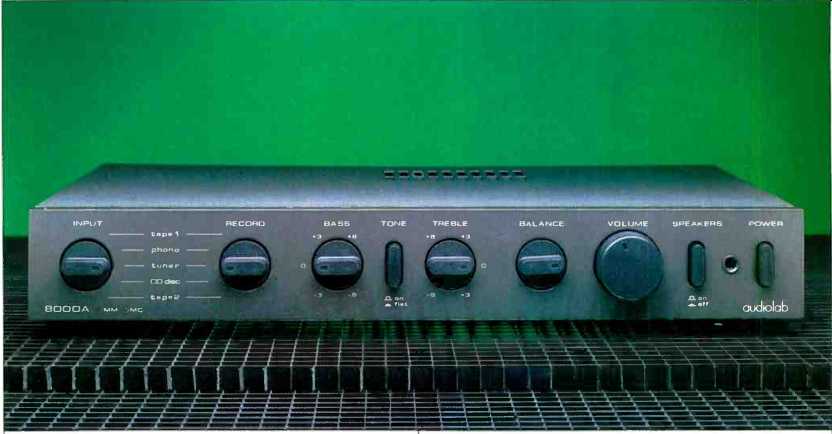
Manufacturer's Specifications:
Power Output: 50 watts per channel, 20 Hz to 20 kHz, both channels driven into 8-ohm loads.
Rated THD: 0.05%. Rated IHF IM: 0.05%.
Frequency Response: Phono, RIAA/IEC, 20 Hz to 20 kHz, ±0.5 dB.
High level, 20 Hz to 20 kHz, ±0.5 dB; 2 Hz to 65 kHz, +0,-3 dB.
Power amp only, 20 Hz to 20 kHz, ±0.3 dB; 1 Hz to 80 kHz, +0, -3 dB.
Channel Balance: Within 1.0 dB.
Input Sensitivity: MM phono, 2.0 mV; MC phono, 110 µV; high level, 100 mV.
Phono Overload: MM, 175 mV; MC, 10 mV. S/N: MM phono, 76 dB; MC phono, 74 dB; high level, 78 dB.
Channel Separation: 60 dB at 1 kHz for any input.
Polarity: Noninverting for all inputs and outputs.
Tone-Control Range: Bass, ±6 dB at 20 Hz; treble, ±6 dB at 20 kHz.
Power Requirements: 120 V, 50/ 60 Hz; maximum power, 250 VA.
Dimensions: 17 1/2 in. W x 2 15/16 in. H x 13 3/8 in. D (44.5 cm x 7.4 cm x 34 cm).
Weight: 16 3/4 lbs. (7.6 kg).
Price: $695.
Company Address: c/o Artech Electronics, P.O. Box 1165, Champlain, N.Y. 12919.
Here's a neat little "sleeper" of an integrated amplifier which would go well with any of the higher efficiency speaker systems that have been introduced since the era of digital audio began in earnest. No bigger than most preamplifiers, the Audiolab 8000A delivers extremely clean sound at power levels well beyond its conservative specifications.

Manufactured in the United Kingdom and distributed by Artech Electronics of Canada, the amplifier has a beautifully styled front panel with easy-to-grip rotary controls and positive-acting pushbutton switches.
This unit's similarity to a preamplifier goes beyond its appearance. As supplied, the "Power Amp In" terminals are internally connected to the "Pre-Amp Out" jacks. However, with a simple internal modification, the preamp and power amp sections can be used independently, for biamped systems or for driving active loudspeakers, for example.
Those "Pre-Amp Out" jacks are driven by an amplifier with low-impedance output so that they can be used to drive other power amps or active speakers, even via long cables, without signal degradation or high-frequency attenuation.
Like many more elaborate (and more expensive) integrated amplifiers, the 8000A provides independent signal source selection for its main and tape outputs. Thus, you can listen to one program source while recording another.
Two full tape monitor loops are provided, and dubbing is possible in either direction between two tape decks.
I was impressed by this amplifier's speaker-switching arrangement; clearly, its designers considered real-world situations and did not add needless switches for their own sake. Though there are two independent sets of speaker terminals at the rear of the amplifier, there is only a single pushbutton speaker switch on the front panel. This switch activates speakers connected to the terminals labeled "Switched Speakers." It's a logical setup; in most practical applications, the main speakers would be on all the time and therefore would require no front-panel switch. Just as logically, should you wish to listen to headphones, insertion of a headphone plug deactivates both sets of speakers, regardless of the setting of that front-panel pushbutton.
I was not supplied with a schematic wiring diagram, but I did remove the 8000A's cover. This revealed a massive power transformer, more than adequate filter capacitance, and a generally neat and well thought-out component layout with sufficient heat-sink area for the output devices.
Control Layout
The power on/off pushbutton is located (surprise!) at the right end of the slim front panel. (Most of us are right-handed, after all. So why do manufacturers make us reach across the front panel to turn our equipment on?) The next control, working right to left, is the "Speakers" on/off pushbutton, and just beyond it is the master volume control. The smaller balance control comes next, followed by calibrated treble and bass controls. Between them is a "Tone" pushbutton, used for defeating the tone-control circuits. At the left end of the panel are two identical rotary knobs. One selects the input you want to listen to, and the other chooses the signal to be sent to the record-out jacks. If the "Record" control is set to "Tape 1," you can dub from the deck connected to the "Tape 1" loop to the deck connected to the "Tape 2" loop. Conversely, if you set the "Record" switch to "Tape 2," you can dub from "Tape 2" to "Tape 1." The "Input" and "Record" selectors are positioned side by side and share one set of nomenclature, printed between them. It took me a while to get used to this arrangement.
Below the "Input" selector are two tiny LED indicators, one labeled "MM," the other "MC." Since the switch that selects the phono preamp mode (MM or MC) is on the rear panel, these fights let the user know which cartridge input circuit is active. And since one of these two lights will always be illuminated when power is applied to the amplifier, there is no need for an additional power-on indicator. In art circles, this might be called a "minimalist" approach. In audio circles, I call it common-sense design.
A power cord is supplied separately, so the amp need not be reconfigured physically for different countries and different voltages. The line fuse, together with a spare, is in a small drawer, on the rear of the amp, that can only be opened once the cord is unplugged. Color-coded speaker terminals are positioned at the left side of the rear panel, near the power-cord receptacle. "Power Amp In" jacks and "Pre-Amp Out' jacks come next, followed by the eight "In" and "Out" jacks associated with the two tape monitor loops.
Next come the high-level input pairs, labeled "CD" and "Tuner." Farther to the right are four jacks associated with the MM phono inputs. Why four? Because two can be used to alter the existing load impedance presented to the phono cartridge if the 47-kilohm resistance and 85-pF capacitance built into the unit are not precisely the values required by your cartridge. To alter those "default" values, you can easily wire up a pair of phono plugs with the right resistance and capacitance in parallel, or you can order the proper load from your dealer. The other pair of MM phono jacks are, of course, for the cartridge itself. At the extreme right of the panel are a pair of MC phono inputs and a switch that selects MM or MC operation. Independent jacks are provided for either type of cartridge. Therefore, if you own both types, mounted in two different tonearms or on two turntables, you can connect one of each and choose between them without having to unplug and plug cartridge cables again and again. A ground terminal in the vicinity of these phono jacks completes the rear-panel layout.
Measurements

Fig. 1--THD + N vs. power into 8 ohms.
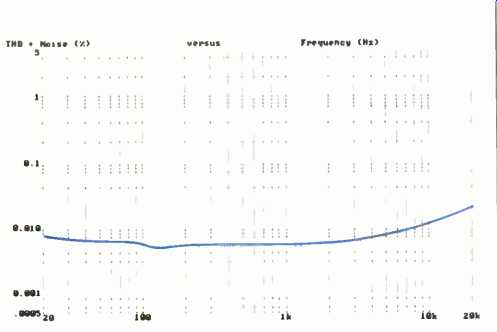
Fig. 2--THD + N vs. frequency at rated output (50 watts) into 8 ohms.
Evaluating the Audiolab 8000A on the lab bench provided my first opportunity to use Audio Precision's System One computerized test equipment for measuring an amplifier's performance. Figure 1 is a plot of THD + N versus power output per channel, with both channels driving 8-ohm resistive loads. The plots are for test frequencies of 1 kHz, 20 Hz, and 20 kHz. Distortion reached its rated level of 0.05% for a 1-kHz signal at around 67 watts, well above the manufacturer's rated level of 50 watts. Even when a 20-kHz test signal was used, power output for 0.05% THD + N was an impressive 63 watts, and at 20 Hz it was 61 watts. Backing off to the rated 50 watts per channel, I plotted distortion versus frequency from 20 Hz to 20 kHz. Results are shown in Fig. 2.
At 1 kHz, the reading was 0.005%, a whole order of magnitude lower than the manufacturer's specification. Worst case THD + N (at 20 kHz) was just under 0.02%, still well below the published rating of 0.05%. Although the manufacturer doesn't provide an FTC power rating for operation with 4-ohm loads, I repeated the measurement using this lower load impedance at the output of each channel. Figure 3 shows how THD + N varied with increasing power output, again for frequencies of 1 kHz, 20 Hz, and 20 kHz. Under steady-state conditions, the high current required for these tests popped the amp's line fuse.
This explains why the curves in Fig. 3 don't extend beyond about 90 watts per channel. Yet even at that power level, worst-case THD + N (for the 20-Hz test signal) was still below 0.05%, with a reading of approximately 0.34%. (Figure 3 is a bit misleading here, as the 20-Hz curve actually represents interpolations between readings taken above and below 90 watts.) Next, I set the test system to provide a constant regulated output of 80 watts per channel into 4 ohms (so as not to pop more fuses) and plotted THD + N versus frequency. Results are shown in Fig. 4: THD + N was only 0.0061% at 1 kHz, 0.028% at 20 Hz, and 0.03% at 20 kHz.
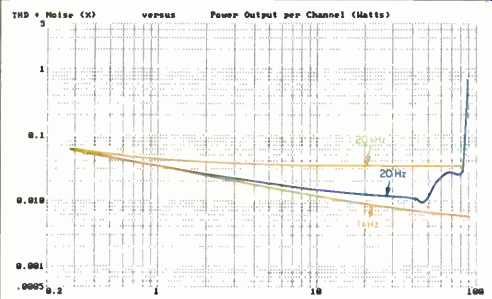
Fig. 3--THD + N vs. power into 4 ohms.

Fig. 4--THD + N vs. frequency at 80 watts into 4 ohms.
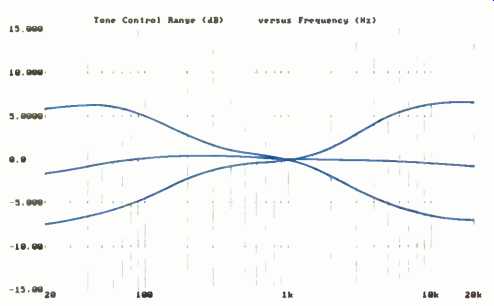
Fig. 5--Tone-control characteristics.
Damping factor, referred to 8 ohms and at a test frequency of 50 Hz, measured 130, and dynamic headroom was a very high 2.77 dB. SMPTE-IM distortion at rated output measured 0.04%, and CCIF IM was also 0.04%. Overall frequency response via the high-level inputs was within 1.18 dB from 20 Hz to 20 kHz when the tone-control circuitry was turned on. Tone-control range was moderate, compared to some amplifiers-a wise design choice for a relatively low-powered integrated amplifier. Furthermore, the tone-control circuitry had only a moderate effect on mid frequencies even when maximum boost or cut was employed. Multiple sweeps, using the Audio Precision test system, produced the composite response curves of Fig. 5. Frequency response with the tone controls out of the circuit was within 3.0 dB from below 10 Hz to 55 kHz.
Figure 6 is a plot of the response characteristics of the phono preamplifier section. Since the 8000A is of European origin, its response curve corresponds to the IEC-modified RIAA Standard. Notice the roll-off below around 35 Hz. This roll-off is of considerable help when using turntables that have a moderate amount of rumble. In this country, the RIAA has obstinately refused to adopt this modification even though it's endorsed by the International Electrotechnical Commission, a world organization charged with setting uniform voluntary standards of measurement for all industrialized nations. In any event, Fig. 7 shows the deviation of the amp's playback response curve from the RIAA Standard. At 20 Hz, it differed by just a bit more than 3 dB. When I inserted the inverse of the IEC-modified filter in the measurement path, the response curve proved to be extremely accurate at the low end; it was off by only -0.3 dB at 20 Hz, as shown in Fig. 8.
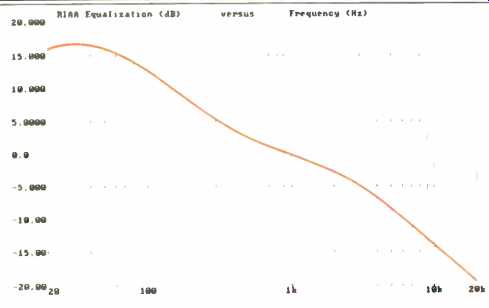
Fig. 6--Response characteristics, phono preamp section. Note roll-off below
35 Hz; see text.
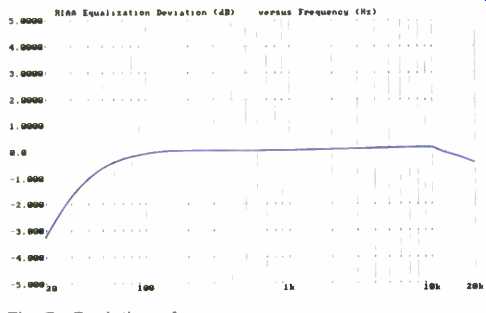
Fig. 7--Deviation of phono playback response from RIAA equalization. See text.
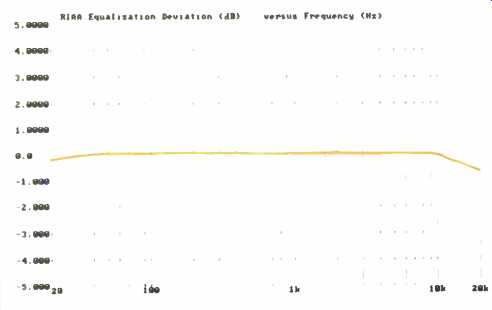
Fig. 8--Deviation of phono playback response from IEC/RIAA equalization. See
text.
Although Audiolab measures signal-to-noise the same way I do (using the IHF/EIA Standard), for some reason they quote input sensitivity based on rated output rather than on 1 watt output. Consequently, my measured input sensitivities do not correlate with the published values. If you want to compare my results with the published specifications, simply multiply my numbers by 7.07 (the input voltage ratio needed to get from 1 watt to 50 watts). Sensitivity for the CD input was 28 mV; other high-level inputs required only 14 mV for 1 watt output. Sensitivity for the MM phono inputs was 0.32 mV, and the MC phono inputs required a signal level of 18.4 11V to produce 1 watt into 8-ohm loads with the volume turned fully up.
Signal-to-noise ratio for the high-level inputs, referred to 1 watt output and with a 0.5-V input, measured slightly more than 96 dB. Residual noise, with the volume control set at minimum, was 100.3 dB. S/N via the MM phono inputs, referred to 1 watt output and with a 5-mV signal applied, was exactly 80 dB; via the MC inputs (using a 0.5-mV input signal to produce 1 watt output), S/N was 75.4 dB at the left channel output and 77.0 dB at the right. All of these results are significantly better than Audiolab's specifications.
Use and Listening Tests
The simple elegance and clean design of this medium powered amplifier was matched by its sound quality. The term "transparency" has perhaps been overused in describing how amplifiers reproduce audio signals, but I can't think of a better term to use with regard to the Audiolab 8000A. To be sure, it wasn't quite powerful enough to drive my KEF 105.2 reference speakers to the levels I like when I auditioned some of my more dynamically recorded CDs, but it came remarkably close. I normally drive these speakers with an amplifier rated at more than 200 watts per side; that should give you some idea of how much dynamic headroom this Audiolab amplifier actually has.
Tone-control action was just the way I like it, with mid settings of these controls producing very subtle changes, rather than crude overall alterations of tonal balance.
Phono inputs were as noise-free as the bench measurements suggested. So for a change, I actually dug out some old LPs, cleaned them well, brushed off the stylus tip of a Shure V15 Type V-MR cartridge, and sat back to listen to some of my favorite Beethoven and Brahms recordings.
Interestingly, with those LPs playing, there was enough power to drive my reference speakers, after all. (I guess it's true what they say about CDs and dynamic range. Sometimes I wonder whether the peaks in CDs aren't occasionally somewhat bigger than in real life.) But I digress. The fact is that the Audiolab 8000A could well serve as the central component in an audio system that employs reasonably efficient loudspeakers in a listening room of average dimensions. You can probably buy a lot more power for the price of this amplifier, but you are not likely to buy better sound quality or a more intelligently configured control layout--not for that sum or, in fact, for even more.
--Leonard Feldman
[AUDIO magazine/April 1988]
Also see: Audiosource RTA-One Real-Time Analyzer (Dec. 1986)